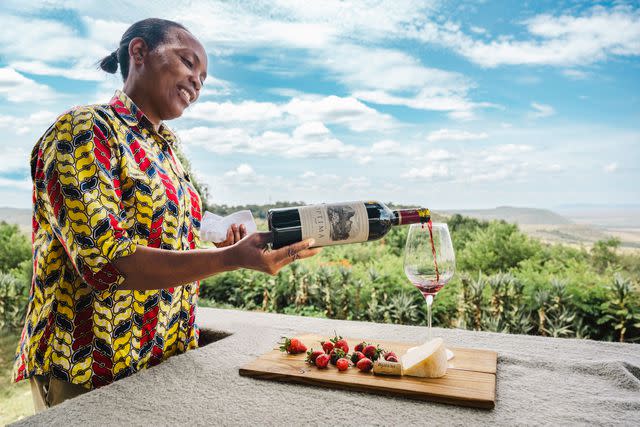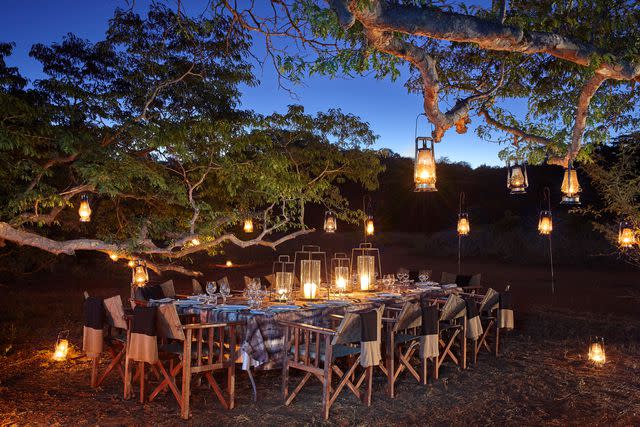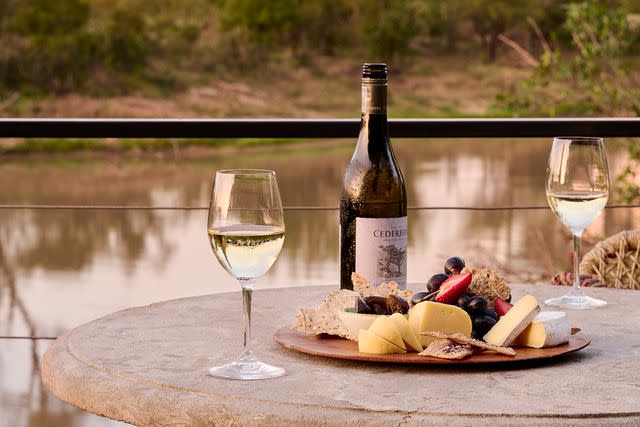Why Some of the World's Best Wines Can Only Be Found at High-end Safari Lodges
The latest safari must-have for the one percent is elusive (and expensive) wine they can’t try anywhere else.

Courtesy of Red Carnation Hotels
A bush picnic for guests of Xigera Safari Lodge, in BotswanaFor most people, it would be the trip of a lifetime. The 40-person wedding party was going on a no-expense-spared safari, complete with a full buyout of Singita’s Sasakwa Lodge, a manor-house-style property overlooking the plains of the Grumeti Game Reserve, near Tanzania’s Serengeti National Park. While wildlife watching was certainly on the agenda, says Mark Lakin, the safari expert and member of T+L’s Travel Advisory Board who helped orchestrate the blowout, these clients were also looking for some of the best wine on the continent. They’d specifically requested Sasakwa because of its well-stocked cellar — and Singita’s growing reputation for sourcing hard-to-find labels.

Courtesy of Angama
Pouring a Bordeauxstyle South African red at Kenya’s Angama Mara“You would never have seen that kind of request ten years ago, where the client is asking about the wine in Tanzania and that being a big part of the draw,” explains Lakin, founder of the Legacy Untold. “But I’m seeing it more and more.”
Singita, which has 15 lodges and tented camps in four African countries, has spent years amassing a trove of wines that today is rumored to top 250,000 bottles. “It’s all driven by the guests’ interest,” explains Francois Rautenbach, general manager of the Singita Premier Wine Direct program, which purchases, cellars, and delivers top-quality labels to remote outposts.

Courtesy of Singita
Dinner by the trees at Singita, Luxury African Safari LodgesOther operators are also responding to the demand, says Allister Kreft, the CEO of Under the Influence, a firm that supplies high-end wine to leading safari companies. “People are willing to explore wine more,” Kreft observes. Recently, his firm worked with Angama Mara, a 30-room safari lodge in Kenya, to develop a new wine list that focuses on African bottlings and also to help educate staff on the finer points of the labels on offer. “The wines guests find here are going to be different from the ones they have at home,” says Adlight Muhambi, one of Angama’s butlers, who has become the property’s unofficial sommelier.
Great Plains Conservation has also put more emphasis on wine, particularly at its Kenya properties, including the six-suite Mara Plains Camp. “We’re very conscious of supporting winemakers that also fund conservation efforts, for example, Painted Wolf Wines from South Africa,” says Savanna McKittrick, a camp operations and guest relations manager for Great Plains. “Some of these are imported just for us, so it’s almost like private label.”

Mark Williams/Courtesy of The Royal Portfolio
Wine and charcuterie board at Waterside Lodge at Royal MalewanRarities can also be found at the 13-suite Xigera Safari Lodge, in Botswana’s Okavango Delta. Numerous high-end wines are included in the rate and available 24/7, says Stefan Otto, Xigera’s food and beverage consultant. “If you want to drink Lanson Le Rosé at six o’clock in the morning, you can,” he says. Oenophiles can also splurge on reserve wines that aren’t included in the rate, such as Dom Pérignon; verticals of Chateau Margaux, one of the famed premiers crus; or a 1998 Chateau Pétrus, from Bordeaux’s right bank.
Other operators are looking beyond wine. The 12-room Waterside at Royal Malewane, which opened in South Africa’s Greater Kruger National Park last year, has the one of the safari industry’s largest selections of single-malt whisky, as well as more than 40 distinctive small-batch gins, many of which hail from South Africa. "Even on safari," says Nicholas Daneel, the lodge manager, "there’s something that will appeal to anyone."
A version of this story first appeared in the September 2023 issue of Travel + Leisure under the headline "Tracking That Trophy Bottle."
For more Travel & Leisure news, make sure to sign up for our newsletter!
Read the original article on Travel & Leisure.